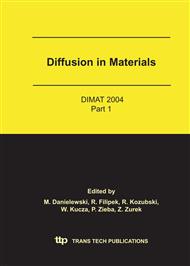[1]
P. Shewmon: Diffusion in Solids 2nd ed. (TMS, Pa., 1989), p.84.
Google Scholar
[2]
E. Hayashi, Y. Kurokawa, Y. Fukai: Phys. Rev. Lett. Vol. 80 (1998), p.5588.
Google Scholar
[3]
Y. Yamazaki, H. Kakuta, M. Okada, Y. Iijima: Defect Diff. Forum Vol. 194-199 (2001), p.1069.
Google Scholar
[4]
Y. Yamazaki, Y. Iijima, M. Okada: Acta Mater. Vol. 52 (2004), p.1247.
Google Scholar
[5]
Y. Yamazaki, Y. Iijima, M. Okada: Phil. Mag. Lett. Vol. 84 (2004), p.165.
Google Scholar
[6]
T.B. Massalski, H. Okamoto, P.R. Subramanian, L. Kacprzak: Binary alloy phase diagrams 2nd. (ASM International, 1990), p.1442.
Google Scholar
[7]
W.M. Albrecht, W.D. Goode, M.W. Mallet: J. Electrochem. Soc. Vol. 106 (1959), p.981.
Google Scholar
[8]
H. Koike, Y. Shizuku, A. Yazaki, Y. Fukai: J. Phys. Condens. Mat. Vol. 16 (2004), p.1335.
Google Scholar
[9]
T.S. Lundy, F.R. Winslow, R.E. Pawel, C.J. McHargue: Trans. AIME Vol. 233 (1965), p.1533.
Google Scholar
[10]
D. Ablitzer: Phil. Mag. Vol. 35 (1977), p.1239.
Google Scholar
[11]
R.E. Einziger, J.N. Mundy, H.A. Hoff: Phys. Rev. B Vol. 17 (1978), p.440.
Google Scholar
[12]
W. Bussmann, C. Herzig, H.A. Hoffand, J.N. Mundy: Phys. Rev. B Vol. 23 (1981), p.6216.
Google Scholar
[13]
Y. Iijima, K. Yamada, H. Katoh, J.K. Kim, K. Hirano: Proceedings of 13th Symposium on Ion Sources and Ion-assisted Techniques, Ionics, Takagi T, ed. (The Ion Engineering Society of Japan; Tokyo: 1990), p.179.
Google Scholar
[14]
P. Shewmon: Diffusion in Solids 2nd ed. (TMS, Pa., 1989), p.14.
Google Scholar
[15]
R.J. Walter, W.T. Chandler: Trans. Met. Soc. AIME Vol. 233 (1965), p.762.
Google Scholar
[16]
A. Seeger, H. Mehrer: Vacancies and Interstitials in Metals Seeger A, Schumacher D, Schilling W, Diehl J, editors. (North-Holland, Amsterdam, 1970), p.1.
Google Scholar
[17]
P. Shewmon: Diffusion in Solids 2nd ed. (TMS, Pa., 1989), p.107.
Google Scholar
[18]
C.P. Flynn: Point Defects and Diffusion Marshall W, Wilkinson DH, editors. (Oxford University Press, London, 1972), p.319.
Google Scholar
[19]
H.B. Huntington, G.A. Shirn, E.S. Wajda: Phys. Rev. Vol. 99 (1955), p.1085.
Google Scholar


